
|
A habitat is an area where an organism lives. An organism finds food, shelter, and everything else it needs to live within its habitat. An aquatic habitat is a habitat with water. It includes areas that are permanently covered by water and surrounding areas that are occasionally covered by water. Estuaries, rivers, and marshes are examples of aquatic habitats. The aquatic habitat of the Altamaha River estuary includes the water and soil in the estuary, and the animals and plants that live in it. The water in an estuary is like a vegetable soup. There are many small pieces of plants and detritus suspended throughout the water. Microscopic organisms and algae grow in the water. Fine sediment and minerals also thicken the water. |
||||||||||||||||||||
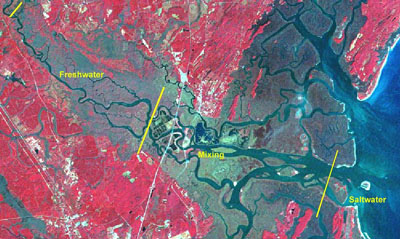 |
||||||||||||||||||||
| click on image for a larger view. | ||||||||||||||||||||
|
Salinity is different in different parts of an estuary (see diagram above). The water is most salty where the river meets the salty ocean. As you move up river, the water becomes less salty. The saltwater from the ocean mixes with the freshwater from the river. The amount of salt in the water also varies at different depths. Saltwater is heavier than freshwater. Therefore, water is saltier at the bottom of the estuary than at the surface. The heaviness of saltwater is why it is easier for people to float in the ocean than in a lake. Ocean water is saltier than the water in our bodies, and so we float. Tides also affect salinity. During high or flood tide, rising levels of ocean water at the shore push more saltwater up into the estuary and river. During low or ebb tide, ocean water draws back from the shore. The estuary is flooded again with freshwater from the river. |
||||||||||||||||||||
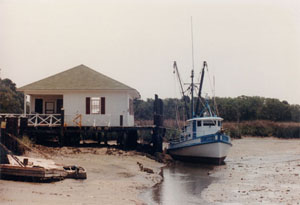 |
||||||||||||||||||||
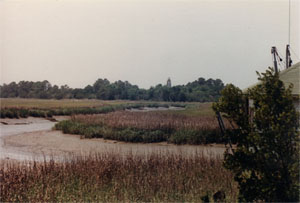 |
||||||||||||||||||||
| Dock at low tide | marsh at low tide | |||||||||||||||||||
| click on images for a larger view | ||||||||||||||||||||
|
Salinity affects where animals and plants live in the estuary. Some organisms are adapted to live in areas with high salinity. Other organisms can only tolerate low levels of salt in the water. They live in areas of low salinity. The soil, or mud, along the bottom of an estuary is very thick and deep. Through time, sediment and detritus settle on the bottom. Many layers develop. The top layer of mud contains a small amount of oxygen. Some small organisms can live and breathe in this layer of mud. The deeper layers of mud, however, contain no oxygen. All the spaces between the mud particles are waterlogged. No organisms live here. As a result, the mud stays thick and chunky. Bacteria and fungi, which normally break down detritus, cannot survive here. Many layers of thick mud build up over time. |
||||||||||||||||||||
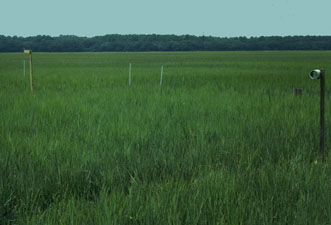 |
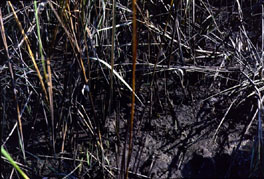 |
|||||||||||||||||||
| Left: Expanse of Spartina alterniflora, salt marsh grass. Above: close-up of Spartina growing in marsh mud. click on the images for a larger view. | ||||||||||||||||||||
|
Many different plants live in different parts of the estuary. Some plants grow in marshes along the edges of the estuary. Their roots grow in the mud and the mud, roots, and stems of the plant are submerged when the tide comes in over the marsh. An example of this is Spartina, a very common cordgrass. Some plants live completely underwater. The seaweed Ulva, an alga known as sea lettuce, is an example. There are also plants that float and drift in the water. Some floating plants are large, and some are tiny. Tiny floating plants are called phytoplankton. Phytoplankton includes a lot of tiny algae. Although the plants that make up phytoplankton are microscopic, they play important ecological roles. Animals, too, live in all the zones of an estuary. Some animals live underwater in the top layer of mud. Oysters are an example. Some are free-swimming, such as striped bass and other fish. Some animals just float and drift in the water. Most of these are so small you need a microscope to see them. They are called zooplankton. Some small animals live on the surface of aquatic plants. For example, snails crawl along the lower stalks of plants. They graze on algae and detritus. |
||||||||||||||||||||
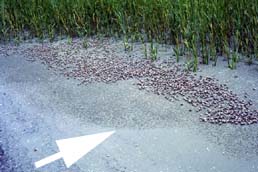 |
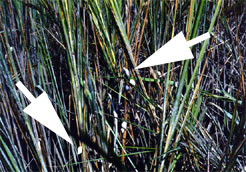 |
|||||||||||||||||||
| Fiddler crabs feeding on an exposed creekbank at low tide. The arrow points to the edge of the area that the crabs have grazed over; the rough appearance is from the feeding pellets produced by the crabs. |
Snails (saltmarsh periwinkles, Littoraria irrorata) climbing on Spartina are highlighted by the arrows. Click on the images for a larger view. |
|||||||||||||||||||